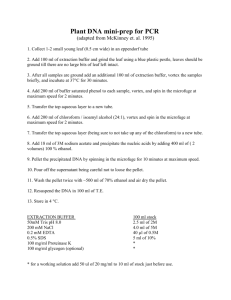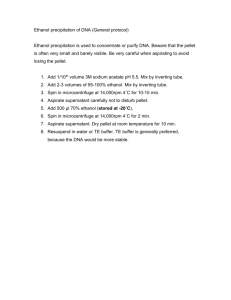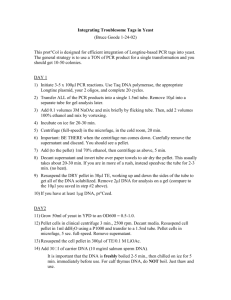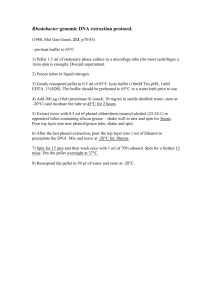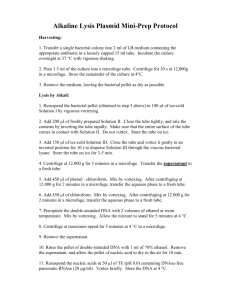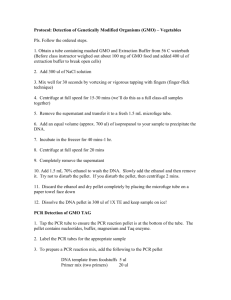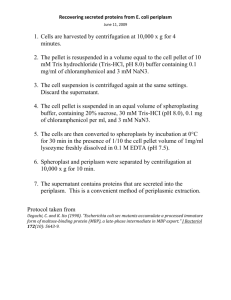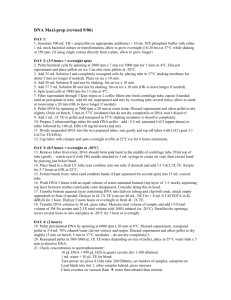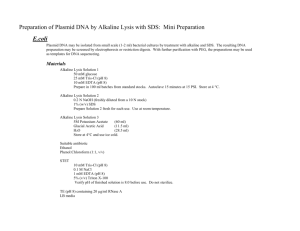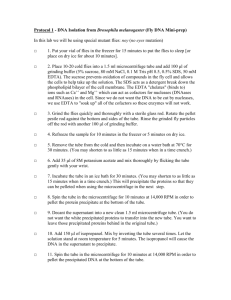Agrobacterium Plasmid Prep
advertisement
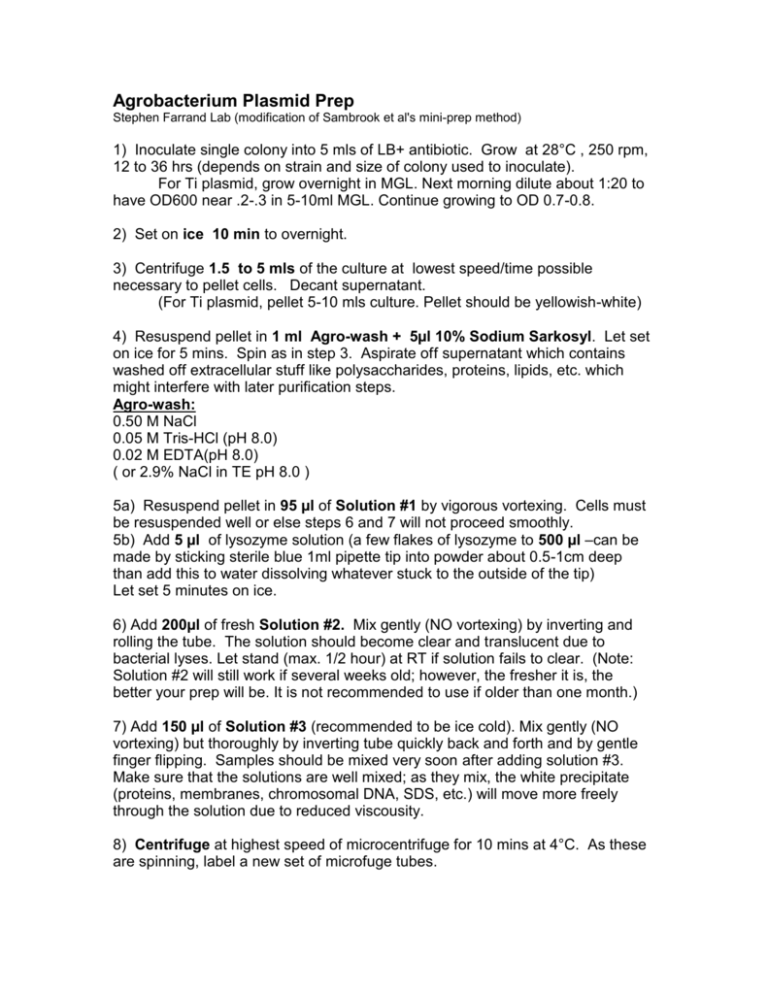
Agrobacterium Plasmid Prep Stephen Farrand Lab (modification of Sambrook et al's mini-prep method) 1) Inoculate single colony into 5 mls of LB+ antibiotic. Grow at 28°C , 250 rpm, 12 to 36 hrs (depends on strain and size of colony used to inoculate). For Ti plasmid, grow overnight in MGL. Next morning dilute about 1:20 to have OD600 near .2-.3 in 5-10ml MGL. Continue growing to OD 0.7-0.8. 2) Set on ice 10 min to overnight. 3) Centrifuge 1.5 to 5 mls of the culture at lowest speed/time possible necessary to pellet cells. Decant supernatant. (For Ti plasmid, pellet 5-10 mls culture. Pellet should be yellowish-white) 4) Resuspend pellet in 1 ml Agro-wash + 5µl 10% Sodium Sarkosyl. Let set on ice for 5 mins. Spin as in step 3. Aspirate off supernatant which contains washed off extracellular stuff like polysaccharides, proteins, lipids, etc. which might interfere with later purification steps. Agro-wash: 0.50 M NaCl 0.05 M Tris-HCl (pH 8.0) 0.02 M EDTA(pH 8.0) ( or 2.9% NaCl in TE pH 8.0 ) 5a) Resuspend pellet in 95 µl of Solution #1 by vigorous vortexing. Cells must be resuspended well or else steps 6 and 7 will not proceed smoothly. 5b) Add 5 µl of lysozyme solution (a few flakes of lysozyme to 500 µl –can be made by sticking sterile blue 1ml pipette tip into powder about 0.5-1cm deep than add this to water dissolving whatever stuck to the outside of the tip) Let set 5 minutes on ice. 6) Add 200µl of fresh Solution #2. Mix gently (NO vortexing) by inverting and rolling the tube. The solution should become clear and translucent due to bacterial lyses. Let stand (max. 1/2 hour) at RT if solution fails to clear. (Note: Solution #2 will still work if several weeks old; however, the fresher it is, the better your prep will be. It is not recommended to use if older than one month.) 7) Add 150 µl of Solution #3 (recommended to be ice cold). Mix gently (NO vortexing) but thoroughly by inverting tube quickly back and forth and by gentle finger flipping. Samples should be mixed very soon after adding solution #3. Make sure that the solutions are well mixed; as they mix, the white precipitate (proteins, membranes, chromosomal DNA, SDS, etc.) will move more freely through the solution due to reduced viscousity. 8) Centrifuge at highest speed of microcentrifuge for 10 mins at 4°C. As these are spinning, label a new set of microfuge tubes. 9) Pour supernatant into new microfuge tube. If lots of precipitate is transfered, it is not too serious and, if desired, this can be removed by several ways: 1.) try using a blue tip (for P1000) -- the precipitate will adhere to the outer walls of the tip. 2.) use a sterile cotton swab (Q-tip). 3.) Transfer to another tube--the precipitate will adhere to walls of previous tube (this is often effective but you'll lose 30 µl or so). 4.) Spin again. 10) Add 450 µl of phenol:chloroform:isoamyl-alcohol (25:24:1). Mix thoroughly by finger flipping until an emulsion forms (will be milky). 11) Centrifuge at high speed for 5 mins at 4°C. While spinning, label new set of tubes and set 70% EtOH on ice, if haven't already done so (for step 16). 12) Transfer the top, aqueous phase to a new 1.5 ml tube. Use cut blue tip (P1000) and be careful not to transfer the junk at the interphase or to transfer any of the organic phase (this will happen if you pipette too quickly). It is better to leave a little of the aqueous phase than to transfer the garbage. Set aside the tube with the aqueous phase (DNA) and save the phenol/chloroform phase for step 13. 13) (optional)Add about 100-150 µl TE to the phenol/chloroform phase to try to recover more DNA. Mix as in step 10 and then repeat steps 11 and 12 adding the aqueous phase to that collected previously (should have 300-400 µl of DNA solution total). 14) Add 95% ethanol to about the 1.5-ml mark (or just under the cap) on tube (want at least 2x amount of ethanol as amount of DNA solution). Mix throughly by finger flipping and inverting tube. 15) Centrifuge at highest speed of microfuge for 10-15 mins at 4°C. 16) Pour off supernatant. Optional further clean-up: Dry pellet in speed vac. Redissolve DNA pellet in 400 µl 0.3 M NaOAc (the proteins won't redissolve well, but the DNA will). The solution should be viscous with some white precipitate floating around in it. Spin at high speed, 5 min to pellet proteins. Decant supernatant to new 1.5 ml tube. Continue from step 14 but place tubes at -80c for 15 minutes after adding the 95% EtOH to aid precipitation of DNA. 17) Add 1ml of ice-cold 70% ethanol. Invert 2-3 times (if pellet comes off the wall of the tube, repeat step 15). Aspirate off the alcohol (be careful of pellet--it might come loose off the wall. Don't worry if cannot aspirate off all the liquid). 18) Dry the pellet in a speed-vac for 3-5 mins. Avoid over drying (pellet should look a little translucent) as this makes it more difficult for DNA to resuspend. 19) Redissolve the DNA pellet in 30-50 µl of TE pH 8.0 with RNAse at 10ug/ml (For Ti plasmid prep, dissolve in 20 ul) Solution #1: 2.25 ml 20% Glucose 1.25 ml 1M TRIS pH8 1.0 ml 0.5M EDTA pH8 45.0 ml milli-Q water Solution #2 2.5 ml 12.5 ml 10.0 ml (prepare fresh): 10% SDS (1% final) 0.4M NaOH (0.2M final) milli-Q water Solution #3: 11.8 g CH3COOK (potassium acetate; 3M final) 4.6 ml CH3COOH (glacial acetic acid 17.4M; 2M final) Bring volume up to 40 ml with milli-Q water. LB (1 liter) 10 g 5g 5g Tryptone NaCl Yeast Extract MGL medium (1 liter) 500 ml LB (5g tryptone, 2.5g yeast extract, 2.5g NaCl) 500 ml water 10 g Mannitol 2.32 g Sodium glutamate (glutamic acid, monosodium salt) 0.5 g KH2PO4 0.2 g NaCl (this is in addition to what is already in the LB) 0.2 g MgSO4 2 µg Biotin (for Biovar 2 strains--not for C58-derived strains) Can be prepared by dissolving 1mg in 100µl 95% EtOH which is 10µg/µl, so add 2µl of this solution. Adjust pH to be close to 7 (takes about 250-300µl of 10M NaOH). However, Phil Oger says that adjusting the pH is not necessary since it is about pH 6.5 prior to adjusting). AUTOCLAVE.
